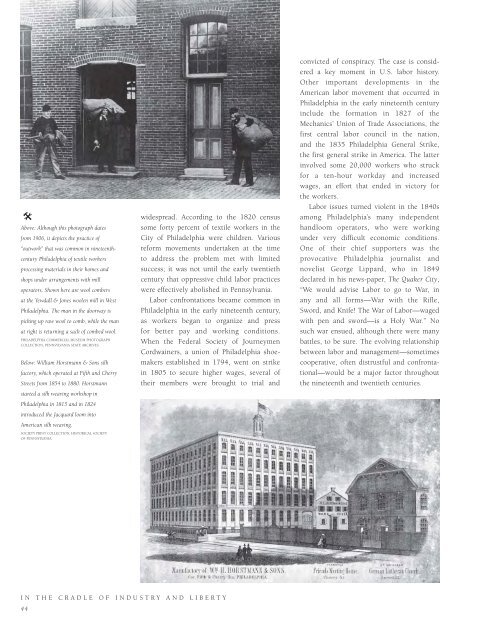In The Cradle of Industry and Liberty
An illustrated history of Philadelphia's manufacturing sector paired with the histories of local companies that make the city great.
An illustrated history of Philadelphia's manufacturing sector paired with the histories of local companies that make the city great.
Create successful ePaper yourself
Turn your PDF publications into a flip-book with our unique Google optimized e-Paper software.
@<br />
Above: Although this photograph dates<br />
from 1906, it depicts the practice <strong>of</strong><br />
“outwork” that was common in nineteenthcentury<br />
Philadelphia <strong>of</strong> textile workers<br />
processing materials in their homes <strong>and</strong><br />
shops under arrangements with mill<br />
operators. Shown here are wool combers<br />
at the Yewdall & Jones woolen mill in West<br />
Philadelphia. <strong>The</strong> man in the doorway is<br />
picking up raw wool to comb, while the man<br />
at right is returning a sack <strong>of</strong> combed wool.<br />
PHILADELPHIA COMMERCIAL MUSEUM PHOTOGRAPH<br />
COLLECTION, PENNSYLVANIA STATE ARCHIVES.<br />
Below: William Horstmann & Sons silk<br />
factory, which operated at Fifth <strong>and</strong> Cherry<br />
Streets from 1854 to 1880. Horstmann<br />
started a silk weaving workshop in<br />
Philadelphia in 1815 <strong>and</strong> in 1824<br />
introduced the Jacquard loom into<br />
American silk weaving.<br />
SOCIETY PRINT COLLECTION, HISTORICAL SOCIETY<br />
OF PENNSYLVANIA.<br />
widespread. According to the 1820 census<br />
some forty percent <strong>of</strong> textile workers in the<br />
City <strong>of</strong> Philadelphia were children. Various<br />
reform movements undertaken at the time<br />
to address the problem met with limited<br />
success; it was not until the early twentieth<br />
century that oppressive child labor practices<br />
were effectively abolished in Pennsylvania.<br />
Labor confrontations became common in<br />
Philadelphia in the early nineteenth century,<br />
as workers began to organize <strong>and</strong> press<br />
for better pay <strong>and</strong> working conditions.<br />
When the Federal Society <strong>of</strong> Journeymen<br />
Cordwainers, a union <strong>of</strong> Philadelphia shoemakers<br />
established in 1794, went on strike<br />
in 1805 to secure higher wages, several <strong>of</strong><br />
their members were brought to trial <strong>and</strong><br />
convicted <strong>of</strong> conspiracy. <strong>The</strong> case is considered<br />
a key moment in U.S. labor history.<br />
Other important developments in the<br />
American labor movement that occurred in<br />
Philadelphia in the early nineteenth century<br />
include the formation in 1827 <strong>of</strong> the<br />
Mechanics’ Union <strong>of</strong> Trade Associations, the<br />
first central labor council in the nation,<br />
<strong>and</strong> the 1835 Philadelphia General Strike,<br />
the first general strike in America. <strong>The</strong> latter<br />
involved some 20,000 workers who struck<br />
for a ten-hour workday <strong>and</strong> increased<br />
wages, an effort that ended in victory for<br />
the workers.<br />
Labor issues turned violent in the 1840s<br />
among Philadelphia’s many independent<br />
h<strong>and</strong>loom operators, who were working<br />
under very difficult economic conditions.<br />
One <strong>of</strong> their chief supporters was the<br />
provocative Philadelphia journalist <strong>and</strong><br />
novelist George Lippard, who in 1849<br />
declared in his news-paper, <strong>The</strong> Quaker City,<br />
“We would advise Labor to go to War, in<br />
any <strong>and</strong> all forms—War with the Rifle,<br />
Sword, <strong>and</strong> Knife! <strong>The</strong> War <strong>of</strong> Labor—waged<br />
with pen <strong>and</strong> sword—is a Holy War.” No<br />
such war ensued, although there were many<br />
battles, to be sure. <strong>The</strong> evolving relationship<br />
between labor <strong>and</strong> management—sometimes<br />
cooperative, <strong>of</strong>ten distrustful <strong>and</strong> confrontational—would<br />
be a major factor throughout<br />
the nineteenth <strong>and</strong> twentieth centuries.<br />
IN THE CRADLE OF INDUSTRY AND LIBERTY<br />
44
















